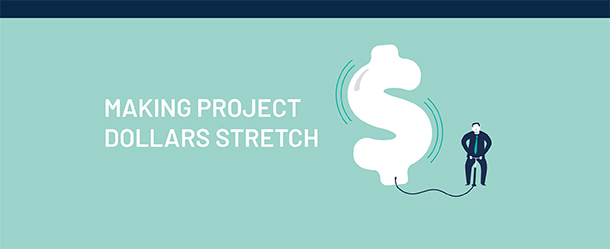



All owners dream of having unlimited funds, or even enough money to simply construct all the facilities they need, but that is rarely the case. Even as economic conditions have improved in recent years, the price of design and construction has continued to rise, making projects feel less affordable than ever. How do owners make available funds go farther? It is at these times that creativity and unconventional thinking are what is needed, and value engineering (VE) workshops give independent stakeholders the opportunity to bring those out-of-the-box ideas to the fore.
On the outside looking in, a value engineering workshop may seem rigid or overly formal, but it is that process itself that has been carefully designed to bring the best minds together, to promote great brainstorming, to elicit the best ideas, and to deliver recommendations with tangible value. Honor the process and it will bring you the outcomes you seek.
It always starts with the right team. An independent team of architects, engineers, and construction professionals is hand-picked, so all the project disciplines are covered, team members have experience on the same type of project they are evaluating, and none of the team members has had any involvement in the project in any way beforehand. Each team member is chosen for a reason and objectivity is essential. They then spend the next 3 to 5 days locked up in a room together with a facilitator. Yes, you read that right. The intent is to create a space, free of interruptions and influences, where the team can do its best work. They spend their time stepping into the shoes of the owner, visualizing how the facility will be used, and brainstorming how to enhance the construction, operation, and maintenance of the facility over the project’s full life cycle.
Once the VE team identifies those ideas that will likely have the most positive impact, they develop formal proposals. This includes quantifying the estimated cost impact (both near-term construction costs as well as overall life cycle cost impacts) and providing a technical justification for making that change. They recognize that their ideas might be met with some resistance. After all, compared to the owner, designer, and stakeholders, they are new to the project and the ideas they may offer might push boundaries. So, they know that their proposals must be compelling and thought-provoking.
How is This Stretching my Dollar?
You may ask why spend money to bring strangers into the process when the project team – owner, designer, and perhaps even contractor/CM at-risk (CMAR) – have been working together for quite a long time to deliver the optimum solution? While the designer certainly has the owner’s best interest in mind, oftentimes decisions are made early in a project and are based on designer preferences or owner-dictated materials/systems that ultimately may not optimize the facility in the long run. Contractors/CMARs often offer cost-cutting measures and ideas that will make the project easier to construct. However, these decisions may benefit the project in the short term (in construction) but may not necessarily make the facility more energy efficient, more durable, or easier to operate and maintain over the many years of use. Sometimes the best thoughts come from disruptive influences, “out of left field,” from another set of eyes. An independent VE team is free from the bias of early decisions and examines the project not only to the point where construction is complete and the contractor/CMAR hands over the keys, but through many years of successful future operation.
Is it worth the money and interruption of the design process? After all, you are spending money to bring in a team of strangers who will most likely recommend you take your design in a different direction that you had contemplated. Why bring in a VE team to stir up trouble? The bottom line is that incorporating VE recommendations has saved clients 5-10% of the project’s construction value and has resulted in facilities requiring less energy, maintenance, and upkeep. Money saved through VE can be used to upgrade features in a project, but also frees up money that owners can invest in other projects. And the cost to perform VE? The typical return on investment (ROI) for VE ranges from 35:1 to 100:1 on building projects, and often exceeds 100:1 on infrastructure projects.
VE has been in use for more than 70 years and it remains as relevant now as it did in its applications during World War II. In the 1940s, industry battled with material shortages and the need to expand production. Now we face labor shortages, material price escalation, ever-increasing complexity of building systems, the demand for sustainable solutions and lower cost of ownership, and many other design and construction challenges. What has remained constant is that unique solutions to these challenges come from the proven processes utilized in VE workshops which promote advanced planning, encourage creativity, and demand holistic thinking.
Comments